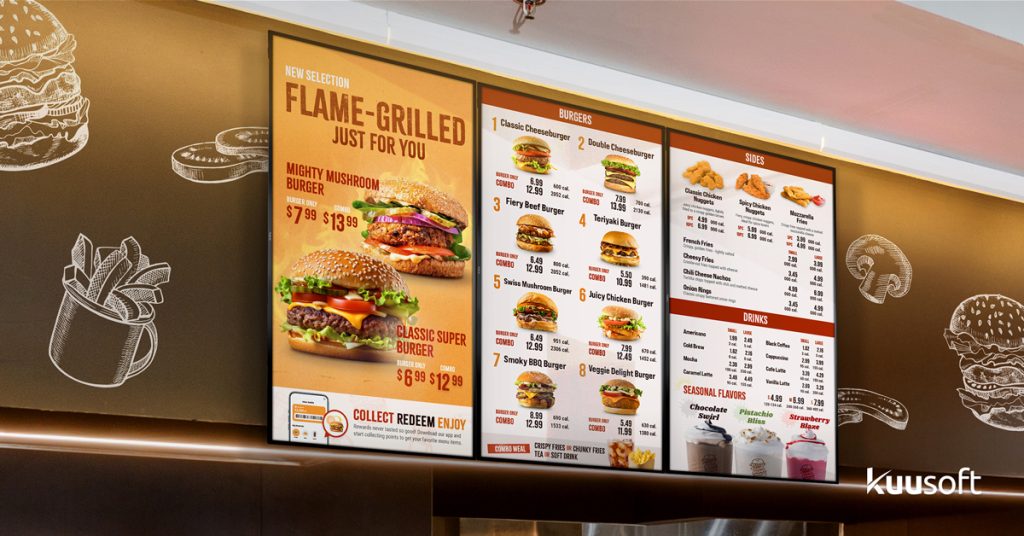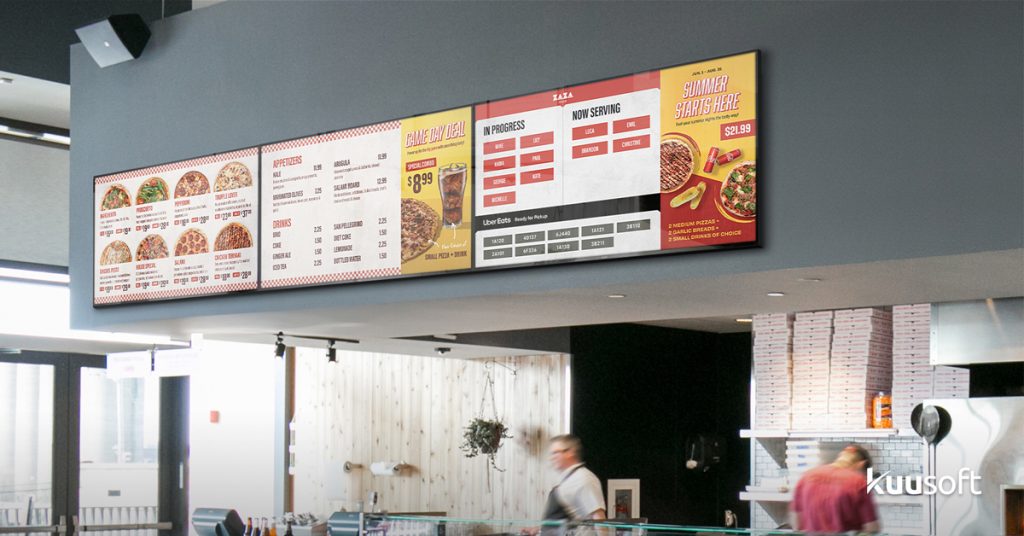
Digital menu boards are an essential part of modern restaurant technology, helping full-service and quick-service restaurants (QSRs) alike attract more customers and boost sales.
Well-designed digital menus do more than look appealing, they influence buying decisions. Studies show that adding digital menu boards can lead to a 3–5% increase in sales on average, and 43% of QSRs report higher sales after switching from print to digital signage.
However, much of this success depends on effective digital menu board design. If your display is cluttered, hard to read, or uses low-resolution visuals with poor contrast, its visibility and impact will suffer. In fact, 74% of QSR customers prioritize easy-to-read menus, proving that clarity is key to conversion.
Key Guidelines for Designing Digital Menu Boards
Here are some basic rules of thumb you should always follow:
1. Optimize Menu Board Placement
Where you position your menu screens directly affects visibility, traffic flow, and customer experience. Consider these placement guidelines:
- Behind the ordering counter — Showcase core items and combos at the point of decision.
- At self-order kiosks — Enable faster, personalized ordering and reduce wait times.
- At the entrance or waiting area — Capture attention early with limited-time offers or new menu items.
- Near dining areas — Reinforce add-on sales (desserts, drinks, loyalty programs).
Keep each screen at eye level, properly angled, and within clear sightlines of ordering zones. Strategic placement ensures maximum visibility and smooth customer flow.
2. Choose the Right Screen Size and Format

Your digital menu board should be large enough to read from 6–10 feet away (the typical viewing distance in QSRs) without overcrowding content. Oversized screens can overwhelm viewers, while undersized ones reduce readability.
When designing your display, remember to:
- Choose a resolution of 1080p or higher for crisp text and images.
- Use simple, legible fonts (e.g., Arial, Roboto, Open Sans) and avoid decorative scripts.
- Organize menu items with clear headings, subheadings, and bullet points so customers can scan quickly.
- Match the screen’s orientation (portrait or landscape) to its location and content type.
This combination ensures clarity, consistency, and brand cohesion across both indoor and drive-thru digital menu boards.
3. Be Mindful of Color Choices
Color impacts perception, appetite, and readability. Choose a color palette that:
- Provide high contrast between text and background for easy reading.
- Align with brand identity, maintain consistent tones across signage, packaging, and décor.
- Use warm colors such as red, yellow, or orange to stimulate appetite and create a sense of urgency.
- Reserve cool tones (blues, greens, etc.) for freshness cues which is ideal for salads, smoothies, or health-focused items.

For digital displays, avoid oversaturation or using too many neon-bright tones at once. A consistent, balanced color scheme maintains a professional visual appeal and improves legibility under different lighting conditions.
4. Use High-Quality Images
Visuals sell the meal before the order is placed. High-resolution, accurate imagery can increase sales by up to 30% when well-executed.
Follow these best practices when adding images to your menu boards:
- Use professional photos of actual menu items and try to avoid stock images that don’t accurately reflect your offerings.
- Optimize images for Full HD or 4K resolution to avoid pixelation on large screens.
- Ensure each image has a consistent lighting style and background for visual cohesion.
- Display popular or high-margin items more prominently to encourage upselling.
People eat with their eyes first, so clear and authentic visuals set expectations and drive purchases.
5. Keep Your Content Updated
One major advantage of digital signage is the ability to update content instantly. Regularly refreshing your menu boards keeps information accurate and engaging while saving on printing costs. Use a centralized content management system (CMS) or digital signage software to push updates in real time across all locations.
Regular updates help you:
- Adjust prices and add new items instantly.
- Promote seasonal specials and limited-time offers (LTOs).
- Mark items as out-of-stock or automatically switch menus based on time of day (e.g., breakfast vs. dinner)
Keeping your menu content fresh and accurate builds trust and encourages repeat visits.
Digital Menu Board Layout Options
One major benefit of using digital menu boards is the flexibility to experiment with various layouts, allowing you to create attractive, dynamic, and easy-to-read menus with ease. Some popular options include:
Grid Layout

This is the simplest and most common layout option, where items are arranged in a grid-like pattern. It’s easy to navigate and can be customized to display images and prices. The grid layout is commonly found in quick-service restaurants, where meal deals are the predominant menu offerings.
Chalkboard/List Layout

A chalkboard or list layout is a popular design choice for digital menu boards, particularly in cafes and casual restaurants. This layout presents menu items in a simple and straightforward manner. It’s a great option for businesses with an extensive menu.
Split-Screen Layout

This layout divides the screen into sections so customers can view different categories or promotions side by side. For example, show main items on one side and limited-time offers on the other. It’s image-heavy and ideal for showcasing specials or comparisons.
Interactive layout

This type of layout is commonly seen on self-ordering kiosks, where customers interact directly with the menu — viewing nutrition info, applying promo codes, customizing orders, and more. Interactive kiosks are becoming increasingly popular in quick-service restaurants because they allow customers to place orders on their own without holding up the line.
Design Dynamic Content
Once your layout, fonts, and imagery are set, take your design further with motion and dynamic content. These elements turn static boards into engaging visual experiences that guide customer attention.
Consider integrating:
- Subtle animations or motion transitions to highlight featured items or time-sensitive offers.
- Create visual hierarchy using animation to emphasize key categories rather than repeatedly showing every item.
- Dynamic scheduling via your CMS to rotate specials, promotions, or breakfast/dinner menus automatically.
- Incorporate purposeful short motion loops or micro-animations — these can increase engagement by 5–10x.
Keep motion effects clean, purposeful, and aligned with the brand’s style. The goal is to enhance visibility and storytelling rather than overwhelm customers.
Maintaining Brand Consistency Across Menu Designs
Every menu screen should be unmistakably the brand’s. Align digital signage design with the brand identity to strengthen recognition and trust.
- Keep colors, fonts, and logo consistent across all displays and marketing materials.
- Mirror the brand’s tone. For example, a premium restaurant might use refined serif fonts, while a quick-service brand could favor bold, energetic typefaces.
Strong visual consistency increases brand recall by up to 80%, helping customers instantly recognize your business.
Preview and Test Before Launch
Before going live, preview your digital menu boards on the actual screens they’ll appear on. Real-world testing ensures the design performs as expected across environments and devices.
Run a complete design check:
- Spelling and pricing — Verify all text and currency details are correct.
- Contrast, brightness, and glare — Test visibility under indoor and outdoor lighting.
- Cropping and aspect ratio – Confirm that no content is cut off on screens of different sizes or orientations.
- Compliance requirements — Add calorie counts or allergen info if regulations apply.
By testing before deployment, you can catch and correct issues early, protect your brand’s integrity, and ensure a flawless launch.
Next Steps
Creating an engaging, well-designed digital menu board is critical for turning hungry visitors into paying customers. With an easy-to-read layout and high-quality images, customers are more likely to order additional items, and staff spend less time explaining the menu.
To bring your digital menu boards to full effect, it is always recommended to work with a professional design team who have experience with designing digital menu boards. Contact us today and find out how we can help you create digital menu boards for your business together.
You can learn more about NexSigns’ Digital Signage solution and connect with us on Facebook, LinkedIn, Twitter, and YouTube to get the latest info on digital signage!






1 comment
Comments are closed.